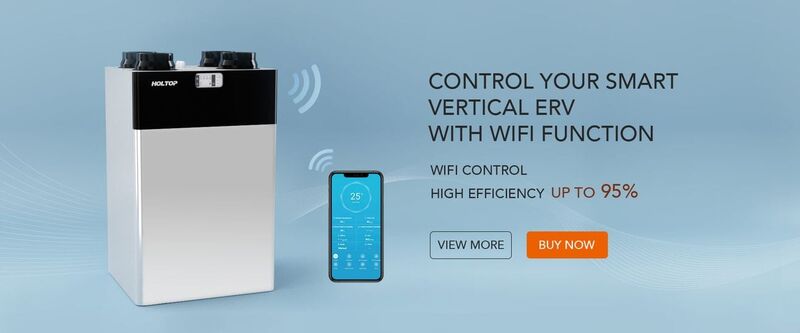At the forefront of innovation, heat recovery ventilators (HRVs) or energy recovery ventilation (ERV) systems transfer heat or coolness from stale exhaust air to fresh intake air. This balanced ventilation solution removes excess moisture, odors, and contaminants while conserving energy and enhancing comfort.
How Does an HRV / ERV System Work?
The whole house heat recovery ventilation system works continuously to extract moist, stale air from wet rooms (kitchens, bathrooms and utility rooms) and supply fresh, filtered air to habitable rooms (bedrooms, living rooms, and dining rooms). Up to 90% of the heat in the extract air is recovered by the heat exchanger in the unit and used to heat the incoming fresh air.
The Importance of Indoor Air Quality
On average, people spend 90% of their time indoors, so clean indoor air is essential for optimum health. Sadly, many homes and businesses have contaminated air.
VOCs, pollen, radon gas, smog, mold, fumes, and odors all degrade home air health. Indoor air pollution can be especially concerning for people who have chronic diseases, compromised immune systems, or mold or chemical sensitivity.
Ventilation systems help prevent mold growth by exhausting excessive moisture that is created by showering, cooking, washing dishes, doing laundry, and engaging in other household activities. All molds produce allergens and irritants, and some molds also produce potentially toxic substances called mycotoxins. Although exposure to mold outdoors rarely concerning, indoor mold growth commonly causes health problems in occupants. Immediate or delayed allergic reactions can be triggered by touching or breathing in mold or mold spores. These reactions include sneezing, a runny nose, red eyes, an asthma attack, and a weakened immune system.
Although the connection between indoor air quality and health issues such as asthma, allergies, and respiratory ailments is common knowledge, the importance of indoor air quality for cognitive function is less understood. Recent workplace studies have demonstrated that indoor air quality affects the ability to concentrate, mood, and anxiety, and longer exposure can even lead to personality changes, impaired memory, and slower cognitive function.
The two best strategies to boost air quality are to keep contaminants out and to dilute airborne pollutants with a mechanical ventilation system. HRV systems use filters to remove many pollutants from the air before it enters homes and commercial spaces. High-MERV filters can stop even small particles, including pollen, bacteria, smoke, smog, and mold spores, from entering your home or business. HRV and ERV systems are also designed to exhaust air specifically from bathrooms, kitchens, and utility rooms, where most home pollutants (fumes, particulates, and excessive moisture that can cause mold) originate.
Energy Efficiency & Comfort
Most ventilation systems drive up heating and cooling costs while decreasing indoor comfort. Much like venting a room by opening a window, ventilation systems can degrade energy performance because they exhaust air without capturing the heat. Because exhaust fans need makeup air to operate properly, they pull in unconditioned air through gaps and cracks in the building exterior, creating drafts. This has a huge impact on both comfort and energy costs!
HRV and ERV systems conserve energy, lowering utility bills. The heat from the exhaust air is transferred to the incoming air via a heat exchanger. heat recovery ventilators are up to 95% efficient, saving energy. This also helps reduce the size of the HVAC equipment needed because it doesn’t have to work as hard to heat and cool when the intake air is conditioned by the HRV unit.
An HRV provides a constant supply of fresh filtered air for the building’s occupants. The higher the heat recovery percentage, the greater the comfort. For example, if the indoor room temperature is 70 degrees Fahrenheit and the outside temperature is 30 degrees, the heat recovery rate could mean the difference between having air in the low 60s coming into the house versus air that is over 65 degrees. Less efficient HRV systems can supply fresh air to living spaces at uncomfortable temperatures. As a result, occupants turn off the unit or use it intermittently. This is a concern because, without the constant ventilation, indoor air quality will suffer.
Common Applications for Heat Recovery Ventilation
There are a variety of residential and commercial applications that are ideally suited for HRV and ERV units. Some local building codes require heat recovery ventilation to promote indoor air quality and energy efficiency. Other projects with tight building enclosures and energy-efficiency goals require heat recovery ventilation to ensure adequate indoor air quality and energy performance.
Detached Houses:
This is one of the most popular applications for HRVs for both new construction and retrofits. Stale air is extracted from bathrooms, kitchens, and utility closets, and fresh air is supplied to bedrooms and living spaces.
Multi-family Buildings:
Urban areas, where apartment buildings and condominiums are common, can have highly polluted air. HRVs filter the intake air, removing many common pollutants.
Schools:
There is a strong connection between cognitive function and indoor air quality. Heat recovery ventilation reduces carbon dioxide levels and filters out many contaminants, helping promote greater classroom learning.
Office Buildings:
Studies have confirmed the impact of indoor air quality on worker productivity and mood. HRVs exhaust toxins and bring in fresh air for a healthier and more productive workplace.
Hospitals and Clinics:
A proper ventilation strategy is essential for preventing the spread of illnesses and promoting optimum health and healing. HRV systems are ideal for hospitals and medical clinics where fresh air is essential.















